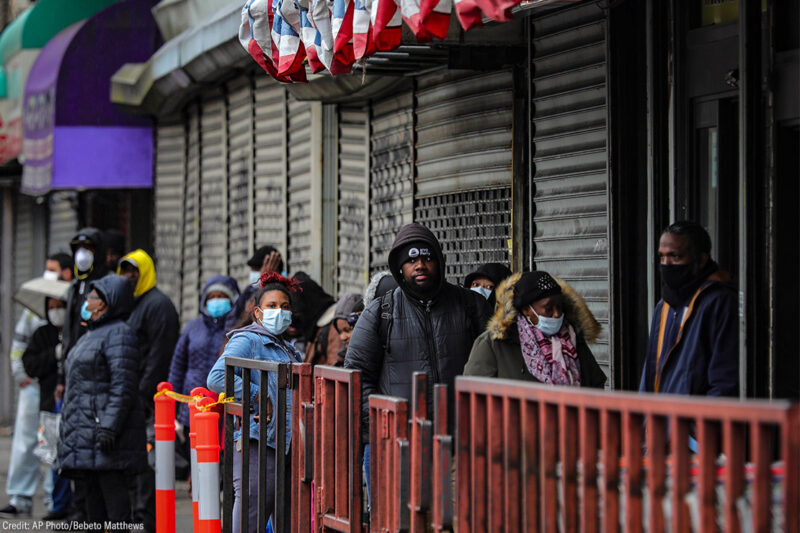If COVID-19 Doesn’t Discriminate, Then Why Are Black People Dying at Higher Rates?


COVID-19 is ravaging many parts of the United States, but nowhere more than in Black communities. Early data from the Midwest and the South reveal that Black people are contracting and dying from the virus at far higher rates than whites. Louisiana just released data which shows that African Americans account for 70 percent of all deaths in the state. In Milwaukee County, 81 percent of those that have died are Black. In Chicago, 70 percent of COVID-19-related deaths are Black. This disease threatens us all, but the Black community has seen the worst effects. These effects point to deeper discrimination throughout society.
There is still a lot more to learn about the virus, but the reason for this racial divide is rooted in governmental failings and bias at federal, state, and local levels. Before the first coronavirus case emerged in the U.S., Black people had higher rates of underlying chronic conditions like asthma, diabetes, and heart disease that reduce survival rates. As the coronavirus spreads and our economy comes to a virtual stand-still, many employees have shifted to remote work arrangements, but less than 1 in 5 African Americans have. The low-wage, no-benefit jobs deemed “essential,” like grocery store clerks, warehouse employees, and home health aides are the jobs that Black and brown people disproportionately fill. Without health insurance, sick leave, or savings, these workers still show up, because the alternative — unemployment, eviction, and starvation for themselves and their families — is worse.
At the federal level, President Trump espouses racist talking points, blames the first Black president for lack of face masks, and champions policies that discriminate against Black and brown people. Since taking office, the Trump administration has overseen the repeal of numerous federal anti-discrimination and economic justice policies and regulations. The Department of Housing and Urban Development moved to roll back fair housing regulations resulting in greater segregation of Black communities and fewer housing options for those with old or minor convictions, and the Department of Labor stripped away minimum wage and overtime protections for low-wage workers, who now must risk their lives working longer hours to make ends meet.
Further, as the COVID-19 crisis has grown, President Trump has consistently failed to heed the advice of public health experts to make testing widely available, especially in communities with high rates of uninsured people, or provide sufficient medical supplies for already under-resourced health care systems. The recently-passed federal relief bills may also fail to provide benefits and aid based on prior convictions or even arrests.
At the state and local level, Black people are more segregated than any other racial or ethnic group in the U.S. This is well-documented in our largest cities, such as New York, Chicago, Detroit, and New Orleans, which report some of the fastest-growing rates of COVID-19 infection, particularly in low-income communities. Blacks also make up more than half the prison population in Michigan, Illinois, Louisiana, and Maryland — all states reporting higher rates of infection and disproportionate spikes in the number of Black people testing positive for COVID-19. Months ago, public health experts noted that overcrowding and lack of soap and cleaning products would lead to the rapid spread of COVID-19 in prisons and jails, while testing and quality health care would remain mostly inaccessible.
Low-income Black people more often face jail time or driver’s license suspensions because they cannot pay fines and fees charged for minor violations such as traffic and parking tickets. These penalties leave thousands dependent on friends or public transportation, unable to practice the social distancing recommended by the CDC and the World Health Organization. The cumulative effect of these racial disparities makes the threat posed by COVID-19 particularly dangerous and urgent for Black and brown communities.
How do we meet these challenges? Consider the flu pandemic of 1918. A hundred years ago, Black people in the U.S were being lynched in the South, denied the right to vote, Jim Crow laws were at their strongest, and mortality rates for conditions like tuberculosis and pneumonia were two to three times higher than for whites. When the Spanish Flu hit this country, thousands of Black people had just arrived to Northern cities as part of the Great Migration, but found themselves redlined and relegated to substandard housing. Medical historian Dr. Vanessa Northington Gamble observed that Black physicians and nurses of the time not only fought for better health care, but for a range of political and social reforms to address the compounded vulnerabilities concentrated within Black communities. Among these reforms, Black health professionals fought for better sanitation management and improved housing conditions in the overcrowded urban tenements where Blacks lived to slow the spread of the Spanish Flu.
Today, the Black community, particularly low-income households, remains vulnerable. To provide meaningful protection and support for allmembers of the community, a COVID-19 response must address the pervasive racial injustices at the federal, state, and local levels.
In the short term, we start by taking several key steps:
- Provide free testing and treatment for COVID-19 for all but especially in locations that are easily accessible to the most vulnerable, including Black communities.
- Collect and report accurate demographic data (including race) on rates of infection and outcomes.
- Release from jails and prisons vulnerable people.
- Remove re-entry barriers by ending punitive criminal background screens for housing, employment, and public benefits. Those returning home from prison and jail need food, safe, stable housing, employment, and health care.
- Provide equitable relief for renters. Less than half of all Black people own their own home compared to 73 percent of white households. Many governors have suspended mortgage payments. To ensure fairness and support for all communities, this must be coupled with a rent suspension.
- Impose a moratorium on court fines and fees and related penalties, including driver’s license suspensions.
- Support workers organizing for better conditions and demand that any additional federal and state pandemic relief put people, not corporations, first. At a minimum, essential workers must receive hazard pay, free health care, paid family and medical leave and safety standards must be in place to protect them from COVID-19.
- Protect the right to vote in this fall’s presidential election and ensure that Black voters are able to cast their ballots and have them counted, even if social distancing measures are still in place.
As we try to stem the spread of the growing pandemic, we also have an opportunity to take ambitious steps toward a more racially just democracy and reimagine healthy, thriving communities for all of us. It is up to our lawmakers and other stakeholders to ensure that this happens.


